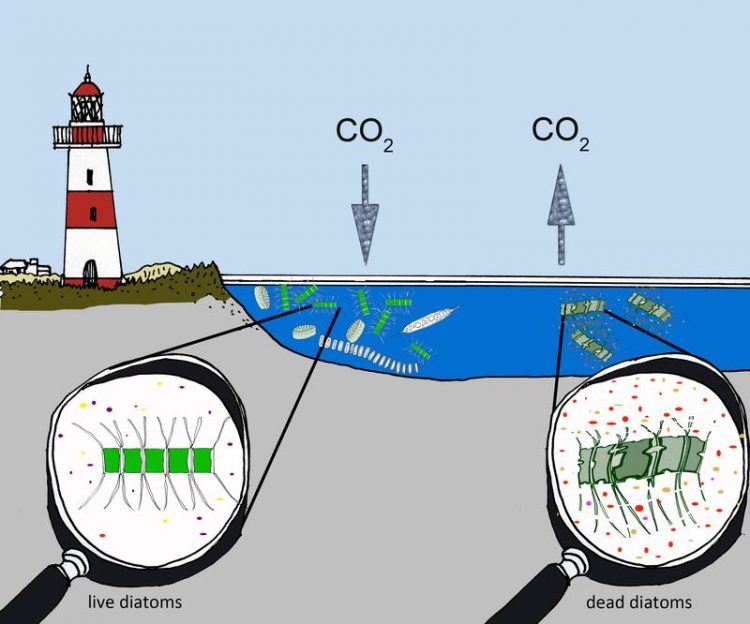The usual suspects: A close-knit bacterial community cleans up blooming algae in the North Sea

Schematic view of the described processes Max Planck Institute for Marine Microbiology, Manfred Schlösser
Thousands and thousands of tiny algae inhabit every millilitre in the ocean. Their impact is massive: Together they produce as much oxygen and remove as much carbon dioxide from the atmosphere as land plants. However, the algae are short-lived. After their death, bacteria decompose them. In the process, the majority of the carbon dioxide previously taken up is released again.
More than 5 million bacterial genes give a glimpse into microbial processes in the German Bight
To understand this aspect of the marine carbon cycle we thus need to investigate how the bacterial community in the ocean decomposes the algae. Therefore, scientists at the Max Planck Institute for Marine Microbiology in collaboration with the Biologische Anstalt Helgoland of the Alfred Wegener Institute conducted an extensive study of bacterial and algal dynamics off the island of Helgoland during the annual spring bloom.
The researchers led by Hanno Teeling, Bernhard Fuchs and Rudolf Amann from the Bremen Max Planck Institute analysed more than 11,000 data points over a period of four years. They analysed nearly 450 billion base pairs of the meta-genome of the resident bacterial communities.
Thereby, they gained information on more than 5 million bacterial genes – corresponding to roughly 200 times the genes of the human genome. There are so many data that the online open access publication, instead of conventional pictures, contains entire posters.
Specialised bacteria break down algal biomass
“From a previous study we know that the bacterial community changes as it degrades the algae spring bloom,” says Hanno Teeling. Specialised bacterial groups accompany different stages of the bloom and gradually degrade most of the algal biomass.
“The present study reveals: It’s obviously far less important than we thought which algae just have their heyday. In different years, different types of algae can dominate the spring bloom “, explains Bernhard Fuchs. “Regardless, we have always observed a similar sequence of dominant groups of bacteria.”
Apparently not the algae themselves but rather their components – above all chains of sugar molecules, the so-called polysaccharides – determine which bacteria will thrive. „It is thus possible that year after year the same bacteria appear, even though the algal bloom can be quite different”, Fuchs explains.
For example: Between 2009 and 2011 diatoms were most abundant in the spring bloom, while in 2012 silicoflagellates of the genus Chattonella prevailed. Nevertheless, the bacterial community that accompanied the bloom was very similar through all those years. This is particularly true within the group Flavobacteria, which seem to play a key role in the degradation of algal polysaccharides. During all four years of the study, Flavobacteria of the genera Polaribacter and Formosa were most abundant.
And it’s not only the bacterial groups always showing the same patterns. „Taking a detailed look at the bacterial genes and what they are actually responsible for, it became clear: It is always a similar temporal sequence of genes that regulate the degradation of certain polysaccharides,” states Hanno Teeling. “This suggests that different algae in the spring bloom have similar or even the same polysaccharides.”
New parts in the carbon puzzle
Next, the researchers from Bremen want to take a close look at the bacterial enzymes that degrade the algal polysaccharides. Which enzymes attack which polysaccharides? What are their exact structures? “From this we can deduce which the main algal polysaccharides are,” explains Rudolf Amann. “And with this information we can then add another piece to the puzzle in our understanding of the carbon cycle of the ocean.”
Original publication
Recurring patterns in bacterioplankton dynamics during coastal spring algae blooms
Hanno Teeling, Bernhard Fuchs, Christin Bennke, Karen Krüger, Meghan Chafee, Lennart Kappelmann, Greta Reintjes, Jost Waldmann, Christian Quast, Frank Oliver Glöckner, Judith Lucas, Antje Wichels, Gunnar Gerdts, Karen Wiltshire, Rudolf Amann
Contact
Dr. Hanno Teeling / 0421 2028 976 / hteeling@mpi-bremen.de
PD Dr. Bernhard Fuchs / 0421 2028 935 / bfuchs@mpi-bremen.de
Prof. Dr. Rudolf Amann / 0421 2028 930 / ramann@mpi-bremen.de
or the press office
Dr. Manfred Schlösser / 0421 2028 704 / presse@mpi-bremen.de
Dr. Fanni Aspetsberger / 0421 2028 947 / presse@mpi-bremen.de
Participating institutes
Max Planck Institute for Marine Microbiology, Bremen, Germany
Alfred Wegener Institute for Polar and Marine Research, Helgoland and List auf Sylt, Germany
http://www.mpi-bremen.de
http://elifesciences.org/content/5/e11888v1
Media Contact
All latest news from the category: Life Sciences and Chemistry
Articles and reports from the Life Sciences and chemistry area deal with applied and basic research into modern biology, chemistry and human medicine.
Valuable information can be found on a range of life sciences fields including bacteriology, biochemistry, bionics, bioinformatics, biophysics, biotechnology, genetics, geobotany, human biology, marine biology, microbiology, molecular biology, cellular biology, zoology, bioinorganic chemistry, microchemistry and environmental chemistry.
Newest articles

Pinpointing hydrogen isotopes in titanium hydride nanofilms
Although it is the smallest and lightest atom, hydrogen can have a big impact by infiltrating other materials and affecting their properties, such as superconductivity and metal-insulator-transitions. Now, researchers from…

A new way of entangling light and sound
For a wide variety of emerging quantum technologies, such as secure quantum communications and quantum computing, quantum entanglement is a prerequisite. Scientists at the Max-Planck-Institute for the Science of Light…

Telescope for NASA’s Roman Mission complete, delivered to Goddard
NASA’s Nancy Grace Roman Space Telescope is one giant step closer to unlocking the mysteries of the universe. The mission has now received its final major delivery: the Optical Telescope…



